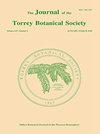Influence of climate factors on demographic changes in the New York populations of the federally-listed Phyllitis scolopendrium (L.) Newm. var. americana
IF 0.8
4区 生物学
Q4 PLANT SCIENCES
引用次数: 6
Abstract
KELSALL, N., C. HAZARD, AND D. J. LEOPOLD (Department of Environmental and Forest Biology, SUNY College of Environmental Science and Forestry, 1 Forestry Drive Syracuse, New York 13210). Influence of climate factors on demographic changes in the New York populations of the federally-listed Phyllitis scolopendrium (L.) Newm. var. americana J. Torrey Bot. Soc. 131:161-168. 2004.-Approximately 92% of the U.S. population of American hart's-tongue fern (Phyllitis scolopendrium var. americana) is found in Onondaga and Madison counties, New York, in 17 distinct colonies. All New York colonies have been periodically censused since 1916, though rarely in the same year. This study examines census data of the total New York population during and following the severe drought of 1999 and during the summers of 2000 and 2002. Additionally, the long-term (1922-2002) census data of seven colonies are examined relative to climate data for the same period. The total New York population has declined overall since the last previous census in 1995. No climate variables explained more than 23% of variation in population size of any growth phase. The lack of controlling, largescale climate factors suggests that the distribution of hart's-tongue fern in New York is determined mostly by the occurence of habitat capable of buffering climatic fluctuations. Future work should combine small-scale habitat and large-scale climate factors in any analysis.气候因素对联邦上市的白桦纽约种群人口变化的影响Newm。var.美国
KELSALL, N. C. HAZARD, AND D. J. LEOPOLD(环境与森林生物系,纽约州立大学环境科学与林业学院,1 Forestry Drive Syracuse, New York 13210)。气候因素对联邦上市的白桦纽约种群人口变化的影响Newm。美国作家j·托里·博特。Soc。131:161 - 168。2004.在美国,大约92%的美洲鹿舌蕨(Phyllitis scolopendrium var. americana)分布在纽约州的奥农达加和麦迪逊县,分布在17个不同的殖民地。自1916年以来,所有纽约殖民地都定期进行人口普查,尽管很少在同一年进行。这项研究检查了1999年严重干旱期间和之后以及2000年和2002年夏季纽约总人口的人口普查数据。此外,将七个殖民地的长期(1922-2002)人口普查数据与同期的气候数据进行了比较。自1995年上次人口普查以来,纽约总人口总体上有所下降。在任何生长阶段,气候变量都不能解释超过23%的种群大小变化。由于缺乏具有控制作用的大尺度气候因子,这表明纽约的鹿舌蕨的分布主要是由能够缓冲气候波动的栖息地的出现所决定的。未来的工作应在任何分析中结合小尺度生境和大尺度气候因子。
本文章由计算机程序翻译,如有差异,请以英文原文为准。
求助全文
约1分钟内获得全文
求助全文
来源期刊
CiteScore
0.70
自引率
0.00%
发文量
16
审稿时长
>12 weeks
期刊介绍:
The Journal of the Torrey Botanical Society (until 1997 the Bulletin of the Torrey Botanical Club), the oldest botanical journal in the Americas, has as its primary goal the dissemination of scientific knowledge about plants (including thallopyhtes and fungi). It publishes basic research in all areas of plant biology, except horticulture, with an emphasis on research done in, and about plants of, the Western Hemisphere.

 求助内容:
求助内容: 应助结果提醒方式:
应助结果提醒方式:


